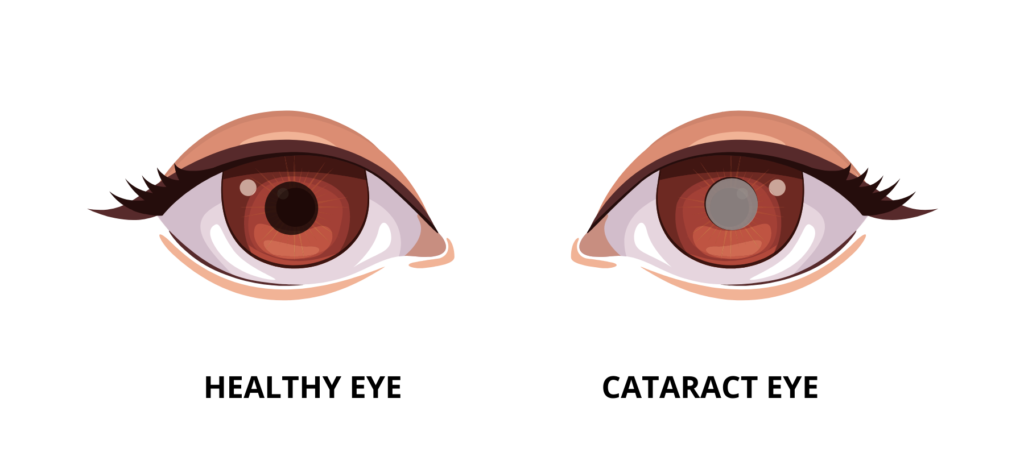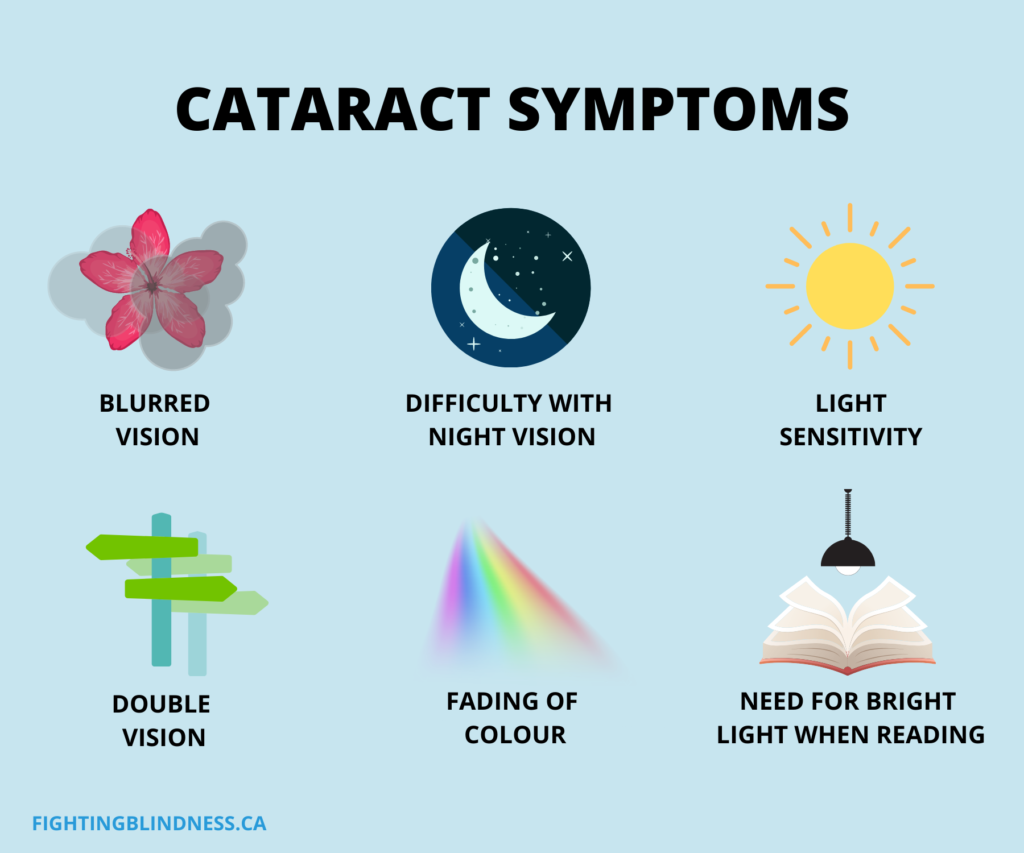Cataracts
Jump to: Symptoms | Diagnosis | Risk Factors | Treatment and Care | Resources
Overview
Cataracts are the most common cause of vision loss in Canada. A cataract is when the lens inside of your eye (behind your pupil) becomes cloudy. Cataracts usually develop in both eyes, but not always evenly. Sometimes you will notice symptoms in one eye before the other. If your symptoms are bothering you and can not be corrected by glasses, the cataracts can be removed with surgery.
As you age, the lens in your eye changes. This is a normal part of aging and almost everyone will develop cataracts as they age. Cataracts are most common after the age of 60. However, cataracts can also develop earlier in life because of injury, inherited genetic conditions, other eye or medical conditions or if you are on specific medications.

There are no proven ways to prevent cataracts. However, there are some steps you can take that may improve your overall health and possibly slow cataract growth:
- Protect your eyes from too much sunlight by wearing sunglasses.
- Quit smoking.
- Manage other health conditions, including diabetes and blood pressure.
- Eat a healthy and varied diet.
SYMPTOMS
Cataract symptoms depend on the type of cataract that is forming. At first, you may not notice any symptoms. If you get regular eye exams, your eye doctor may diagnose you with a cataract before you notice any changes. It is important to see your eye doctor regularly and report any new or worsening symptoms.
Over time you may experience the following symptoms:
- Cloudy, blurry, or double vision
- Difficulty seeing at night.
- Sensitivity to glare or bright lights
- Seeing halos around lights
- Changing colors or inability to identify certain colors.

DIAGNOSIS
Your eye doctor may identify a cataract during an eye exam. There are three tests your doctor can do to determine the appearance, location, and size of the cataract and how it impacts your vision.
- The slit-lamp is a microscope with a bright light that helps the doctor see the structure of the front of your eye, including the cornea, iris, and lens.
- Your eye doctor will perform a retinal exam after administering dilating eye drops to identify signs of cataracts, and other eye diseases like glaucoma.
- A visual acuity test is used to measure the sharpness and clarity of your vision.
RISK FACTORS
The risk of cataracts increases as you age. 75% of Canadians who report cataracts are over the age of 60. In addition, certain health conditions and behaviours increase your risk of cataracts, including:
- Diabetes
- Obesity
- Exposure to sunlight
- Smoking
- High blood pressure
- Injury to the eye
- Eye surgery (for glaucoma or retinal diseases)
- Extended use of steroid medications (both topical and systemic)
- Excessive alcohol consumption
- Other genetic disorders that predispose you to cataracts (such as retinitis pigmentosa)
EXISTING TREATMENTS AND STANDARD OF CARE
When cataracts are forming, they may not interfere with your vision or quality of life. If you have been diagnosed with cataracts, your eye doctor will monitor the size of the cataract and how it affects your vision. If you have cataracts, you may need new eyeglasses to help you see. You may also find that changing the lighting can help you see better. It is important to see your eye doctor regularly and report any new or worsening symptoms.
CATARACT SURGERY
If the cataracts are affecting your vision and quality of life, your eye doctor may recommend cataract surgery. This surgery is a safe and effective way to treat cataracts and is an outpatient procedure. You do not have to stay in the hospital overnight.
Note: If you need cataract surgery in both eyes, you will usually have two separate surgeries, a few weeks to a few months apart.
What to expect during surgery…
You are usually awake during cataract surgery, and the surgeon numbs the eye so you will not feel any discomfort. During cataract surgery, the surgeon will make a small cut in your eye, remove the cloudy lens, and replace it with an artificial lens.
The artificial or intraocular lens (IOL) is placed where your lens used to be. There are many kinds of IOLs, and you should discuss this with your surgeon. Most provincial health care plans will pay for a standard IOL that will help you see better but you will likely still need glasses for reading or computer use. There are special lenses that can help correct refractive errors, which can help you see without glasses or reduce your need for glasses.
Cataract surgery has a very high success rate. In almost all patients, visual acuity is improved dramatically after surgery, within a few days after surgery.
What to expect after surgery…
After surgery, you may feel mild discomfort for a few days. The risk of surgery is very low (less than 1%) meaning that most people will not have any complications. Some of the complications that can occur are infection, excess bleeding, and a higher risk for retinal detachment. Before you get cataract surgery, talk to your doctor about other rare complications. You should report any new or worsening symptoms after surgery to your doctor immediately.
Other considerations…
Some people with glaucoma experience changes in eye pressure after cataract surgery. If you have glaucoma, it is best to discuss your cataract treatment plan with your doctor, who can monitor your glaucoma symptoms closely after surgery.
People who have retinitis pigmentosa (RP) are at an increased risk of developing cataracts at an early age. People with RP who choose to have cataract surgery may have different results than described above. Visual acuity may not change after cataract surgery, and in a small number of individuals with RP, a different type of cataract may form after surgery and a second treatment or surgery may be recommended. Generally, cataract surgery is well tolerated. If you have RP and are considering cataract surgery, discuss potential outcomes with your retina specialist.
RESOURCES
Do you have questions about your eye health or information shared on this page? Our Health Information Line is here to support you. For resources on how to monitor your risk to prevent sight loss, check out the following resources:
- View Point Education Webinar Series Playlist
- View Point ‘All About Cataracts’ Webinar Recording (also below)
- Low vision solutions video
- Cataract Tip Sheet ENGLISH | FRANÇAIS
Learn more about cataracts via the following video.
Tell us what it’s like to live with cataracts.
Share your experience by filling out our survey using the button below.
Learn more about how to share your story with us.
Updated on May 31, 2021.
Join the Fight!
Learn how your support is helping to bring a future without blindness into focus! Be the first to learn about the latest breakthroughs in vision research and events in your community by subscribing to our e-newsletter that lands in inboxes the beginning of each month.

